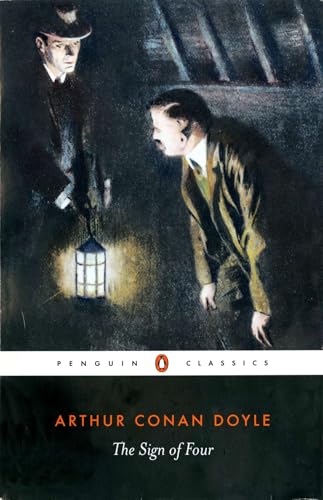 I always like to get some Sherlock Holmes in during the R. I. P. Challenge–by which I mean Sir Arthur Conan Doyle, though I’ve enjoyed some adaptations too. This year I read The Sign of Four, which I’ve been meaning to read ever since I went on the Sherlock Holmes walking tour in London (in 2012, so it’s been a while). The guide talked about the plot, and I realized I didn’t remember a story about a one-legged man and a chest of jewels. I bought a Complete Holmes years ago, and have now completely lost track of which parts of it I’ve read…
I always like to get some Sherlock Holmes in during the R. I. P. Challenge–by which I mean Sir Arthur Conan Doyle, though I’ve enjoyed some adaptations too. This year I read The Sign of Four, which I’ve been meaning to read ever since I went on the Sherlock Holmes walking tour in London (in 2012, so it’s been a while). The guide talked about the plot, and I realized I didn’t remember a story about a one-legged man and a chest of jewels. I bought a Complete Holmes years ago, and have now completely lost track of which parts of it I’ve read…
Now that I’ve read The Sign of Four, I’m pretty sure I hadn’t read it before. I might have forgotten the one-legged man, but I would have remembered the novel that introduced Watson’s wife! She comes to 221B Baker Street because of a mysterious letter relating to her father’s disappearance. The disappearance is quickly solved, but in the process, Holmes and Watson are set on the trail of a murder, a vanished treasure, and a one-legged man.
This is one of the more fantastical Holmes adventures, and Doyle gave a free rein to all sorts of wild weirdness. The book is quite short and fast-paced, and I enjoyed the rush of the adventure. Doyle uses one of his favorite devices of a third-party telling an extended narrative/backstory, but this one doesn’t bog down the way some others have (I’m looking at you, Valley of Fear).
As usual with the character, Watson is likable and well-meaning and considerate of the people involved, while Holmes is all about the hunt. The introduction of Mary added an extra element–although not as much of one as I would have hoped. Doyle could be brilliant and subtle and minutely detailed with regard to Holmes’ clues. Not so much with Watson’s romance. There’s a lovely instinctive handclasp between Watson and Mary at one moment–but that’s about all this romance is hanging on!
It actually makes me wonder as a writer why Doyle made the choice to marry Watson at all. Taking Watson out of Baker Street is inconvenient for later stories, and if you’re not going to do much with a romance, why bother? And I’m fairly sure Mary disappears after this, apart from passing references.
So that was a little disappointing, but since the stories have always been all about Holmes and Watson really, it wasn’t too essential a point. The novel is a more problematic in two other areas. It features Holmes’ most blatant cocaine use that I can recall, as well as an African character who is pretty clearly subhuman. In slight defense of the second point, the character is described as being from a particular, degenerate tribe, and so is not necessarily intended as a reflection of all Africans…but it’s still an iffy thing! The first point I’m mostly willing to give a pass to as a product of its time when less was understood about cocaine use–although considering Dr. Watson knows it’s bad for Holmes, Doyle must have had some knowledge. And that does lead to a rather mixed message–Watson is against drug use while Holmes is blase, so what conclusion is the author telling us to draw? I don’t know, but it’s still a somewhat jarring scene.
At the end of the day, this was a good but not great Holmes novel…but I enjoyed the read, and I spent a lot of it having BBC Sherlock echoes. Which is not a bad thing!
Author’s Site: http://www.sirarthurconandoyle.com/
Other reviews:
Literary Exploration
The Great Detectives
The Literary Omnivore
Anyone else?
Buy it here: The Sign of Four

I need to read more Holmes. I’ve only read one of the novels and one or two of the short stories. I’ve liked them, of course, and love the characters and the various movies and television adaptations of their adventures.
I wonder how much knowledge there was in Doyle’s time of the negative consequences of cocaine use? So many vices back in the day were seen as relatively harmless, including drinking, smoking, etc., when it came to their serious health consequences. Even if people realized they weren’t beneficial, they certainly didn’t grasp the extent of the harm these substances could do the way we understand them now. It must be jarring to read about cocaine use described so casually, like watching smoking glamorized in the 1940’s movies.
I have been so busy recently reading the Sherlock Holmes short story collections but I seem to have completely neglected the novels. I really must get on with reading them too.